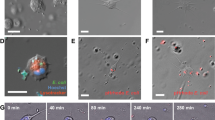Abstract
The sea anemone Anthopleura elegantissima lives in clonal colonies1–3 and possesses a cellular recognition system of remarkable specificity4, by which it can recognize members of its own clone; other anemones, including individuals of the same species which are not syngeneic, are attacked. Attack is initiated by contact with a foreign anthozoan and involves the inflation of specialized tentacle-like structures known as acrorhagi, which contain numerous stinging cells1,2. These stinging cells only discharge when the tip of the acrorhagus is in physical contact with the surface of a foreign anthozoan; contact with syngeneic individuals, organisms other than anthozoans and inanimate objects does not elicit discharge4. We show here that the recognition of allogeneic tissue is accompanied by a novel form of local electrical activity in the acrorhagus that is usually, but not invariably, followed by nematocyst discharge. This type of electrical activity was not found during contact with syngeneic tissue or inanimate objects and seemed to be a consequence of the recognition of allogeneic surface markers by cells at the tip of the acrorhagus.
This is a preview of subscription content, access via your institution
Access options
Subscribe to this journal
Receive 51 print issues and online access
$199.00 per year
only $3.90 per issue
Buy this article
- Purchase on Springer Link
- Instant access to full article PDF
Prices may be subject to local taxes which are calculated during checkout
Similar content being viewed by others
References
Francis, L. Biol. Bull. 144, 64–72 (1973).
Francis, L. Biol. Bull. 144, 73–92 (1973).
Francis, L. Am. Zool. 19, 669–681 (1979).
Lubbock, R. Proc. natn. Acad. Sci. U.S.A. 77, 6667–6669 (1980).
Josephson, R. K. J. exp. Biol. 45, 305–320 (1966).
Macfarlane, I. D. J. exp. Biol. 51, 377–385 (1969).
Shelton, G. A. B. in Electrical Conduction and Behaviour in “Simple” Invertebrates (ed. Shelton, G. A. B.) (Oxford University Press, 1980).
Lubbock, R. J. exp. Biol. 83, 283–292 (1979).
Author information
Authors and Affiliations
Rights and permissions
About this article
Cite this article
Lubbock, R., Shelton, G. Electrical activity following cellular recognition of self and non-self in a sea anemone. Nature 289, 59–60 (1981). https://doi.org/10.1038/289059a0
Received:
Accepted:
Issue Date:
DOI: https://doi.org/10.1038/289059a0
This article is cited by
-
A tentacle for every occasion: comparing the hunting tentacles and sweeper tentacles, used for territorial competition, in the coral Galaxea fascicularis
BMC Genomics (2020)
-
Experimental habituation of aggression in the sea anemone Actinia equina
Hydrobiologia (1991)
-
Acrorhagi, catch tentacles and sweeper tentacles: a synopsis of ?aggression? of actiniarian and scleractinian Cnidaria
Hydrobiologia (1991)
Comments
By submitting a comment you agree to abide by our Terms and Community Guidelines. If you find something abusive or that does not comply with our terms or guidelines please flag it as inappropriate.



